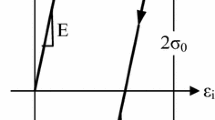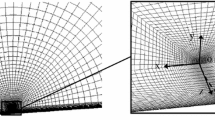Abstract
This paper presents recent work on finite element modelling of plasticity-induced fatigue crack closure occurring in cracks which are inclined to the loading axis, and which may then develop a kink. Such crack deviations occur naturally during crack growth, and improved life prediction models require understanding of the effects of such inclined sections on closure, and of the parameters that influence this response. A full description of the closure response for such cracks, requires insight into both plasticity-induced and roughness-induced closure. The work reported here develops a finite element (FE) model for plasticity-induced closure model, which implicitly considers macroscopic roughness effects through crack inclination and kink development. Some examination of micro-roughness effects is planned for future work. Results from the model were tested against experimental data obtained from 2 mm thick SENT specimens, intended to simulate a state of plane stress, and reasonable agreement found between predicted and observed closure values. The FE model was used to simulate the effects of some fundamental factors affecting fatigue crack closure behaviour for inclined cracks, including the effects of initial angle to the transverse specimen axis, crack path kink angle, friction between crack surfaces, stress or load ratio (R =S min/S max), and stress state. Two parameter crack growth modelling (ΔK eff and K max) was performed as a function of stress ratio, using nonlinear regression to fit model-based ΔK eff values to experimentally observed growth rates for a kinked crack. Good agreement was observed, indicating the utility of the FE model.
Similar content being viewed by others
References
Ashbaugh, N.E. et al. (1997). Experimental and analytical estimates of fatigue crack closure in an aluminiumcopper alloy. Part II: a finite element analysis. Fatigue Fracture of Engineering Materials Structures 20, 963–974.
Budiansky, B. and Hutchinson, J.W. (1978). Analysis of closure in fatigue crack growth. Journal of Applied Mechanics 45, 267–276.
Blom, A.F. and Holm, D.K. (1985). An experimental and numerical study of crack closure. Engineering Fracture Mechanics 22, 997–1011.
Blom, A.F. and Holm, D.K. (1992). Numerical Assessment of Compliance Techniques for Crack Closure Measurements. The Aeronautical Research Institute of Sweden, Report FFAP-1181.
Chermahini, R.G., Shivakumar, K.N., Jr. and Newman, J.C. (1980). Three-Dimensional Finite-Element Simulation of Fatigue Crack Growth and Closure. In: Mechanics of Fatigue Crack Closure (edited by Newman J.C. Jr. and Elber W.), ASTM STP 982, 398–413.
Davis, J.R. et al. (1993). Aluminium and Aluminium Alloys, ASM International, Materials Park, Ohio.
Donald, J.K. (1999). Introducing the compliance ratio concept for determining effective stress intensity. International Journal of Fatigue 19, S191–S195.
Elber, W. (1970). Fatigue crack closure under cyclic tension. Engineering Fracture Mechanics 2, 37–45.
Fleck, N.A. (1986). Finite element analysis of plasticity-induced crack closure under plane strain conditions. Engineering Fracture Mechanics 25, 441–449.
Gan, D. and Weertman, J. (1981). Crack closure and crack propagation rates in 7050 aluminium. Engineering Fracture Mechanics 15, 87–106.
Iida, S. and Kobayashi, A.S. (1969). Crack-propagation rate in 7075-T6 plates under cyclic tensile and transverse shear loadings. Journal of Basic Engineering, Trans. of the ASME, 764–769.
James, M.N. (1997). Some Unresolved Issues with Fatigue Crack Closure – Measurement, Mechanism and Interpretation Problems. Advances Fracture Research (edited by Karihaloo B.L. et al.), Proceedings of the Ninth International Conference on Fracture, Sydney, Australia, vol. 5. Amsterdam: Pergamon Press, pp.2403–2414.
James, M.N. and Li, Wenfong. (1999). Fatigue crack growth in austempered ductile and grey cast irons – stress ratio effects in air and mine water. Materials Science and Engineering A265, 129–139.
Kang, K.J. et al. (1989). Fatigue crack growth and closure through a tensile residual stress field under compressive applied loading. Fatigue Fracture of Engineering Materials Structures 12, 363–376.
Kikukawa, M., Jono, M. and Tanaka, K. (1976). Fatigue Crack Closure Behaviour at Low Stress Intensity Level. In: Proceedings of the Second International Conference on Mechanical Engineering Material, special volume, Boston, USA, 254–278.
Larsen, J.M. and Jira, J.R. (1991). Small-crack closure measurements in titanium alloys. Experimental Mechanics 48, 82–87.
Llorca, J. (1992). Roughness-induced fatigue crack closure: A numerical study. Fatigue Fracture of Engineering Materials Structures 15, 655–669.
Louwaard, E.P. (1977). Report LR-243, Department of Aerospace Engineering, Delft University of Technology, The Netherlands.
McClung, R.C. and Sehitoglu, H. (1989). On the finite element analysis of fatigue crack closure-1. Basic modeling issues. Engineering Fracture Mechanics 33, 237–252.
McClung, R.C. and Sehitoglu, H. (1989b). On the finite element analysis of fatigue crack closure-2. Numerical results. Engineering Fracture Mechanics 33, 253–272.
Nakagaki, M. and Atluri, S.N. (1980). Elastic-plastic analysis of fatigue crack closure in Modes I and II. American Institute of Aeronautics and Astronautics (AIAA) Journal 18, 1110–1117.
Nakamura, H., Kobayashi, H., Yanase, S. and Nakazawa, H. (1983). Finite Element Analysis of Fatigue Crack Closure in Compact Specimen. In: Mechanical Behaviour of Materials (ICM 4), Fourth International Conference on the Mechanical Behaviour of Materials, Stockholm, Vol. 2, 817–823.
Newman, J.C. (1976). A finite element analysis of fatigue crack closure. Mechanics of Fatigue Crack Growth, ASTM STP 590, 281–301.
Newman, J.C. (1981). A Crack Closure Model for Predicting Fatigue Crack Growth Under Aircraft Spectrum Loading. In: Methods and Models for Predicting Fatigue Crack Growth under Random Loading (edited by Chang J.B. and Hudson C.M.), ASTM STP 748, 53–84.
Newman, J.C. (1997). The Merging of Fatigue and Fracture Mechanics Concepts: a Historical Perspective, In: Fatigue and Fracture Mechanics (edited by Underwood J.H. et al.), 1321, 3–51.
Ogura, K. and Ohji, K. (1977). FEM analysis of crack closure and delay effect in fatigue crack growth under variable amplitude loading. Engineering Fracture Mechanics 9, 471–480.
Qian, J. and Fatemi, A. (1996). Mixed mode fatigue crack growth: A literature survey. Engineering Fracture Mechanics 55, 969–990.
Sehitoglu, H. and Sun, W. (1991). Modelling of plane strain fatigue crack closure. Journal of Engineering Materials and Technology 113, 31–40.
Suresh, S. (1985). Fatigue crack deflection and fracture surface contact: micromechanical models. Metallurgical Transactions 16A, 249–260.
Suresh, S. (1998). Fatigue of Materials, The University Press, Cambridge.
Tanaka, K. (1974). Fatigue crack propagation from a crack inclined to the cyclic tensile axis. Engineering Fracture Mechanics 6, 493–507.
Wei, L.-W. and James, M.N. (2000). A study of fatigue crack closure in polycarbonate CT specimens. Engineering Fracture Mechanics 66, 223–242.
Wu, J. and Ellyin, F. (1996). A study of fatigue crack closure by elastic-plastic finite element analysis for constantamplitude loading. International Journal of Fracture 82, 43–65.
Author information
Authors and Affiliations
Rights and permissions
About this article
Cite this article
Wei, LW., James, M. Fatigue crack closure for inclined and kinked cracks. International Journal of Fracture 116, 25–50 (2002). https://doi.org/10.1023/A:1020189817060
Issue Date:
DOI: https://doi.org/10.1023/A:1020189817060




